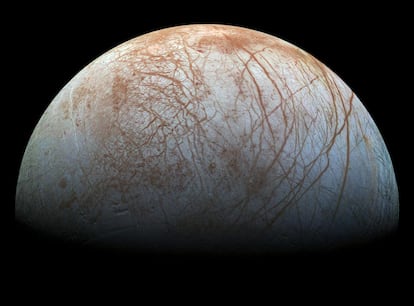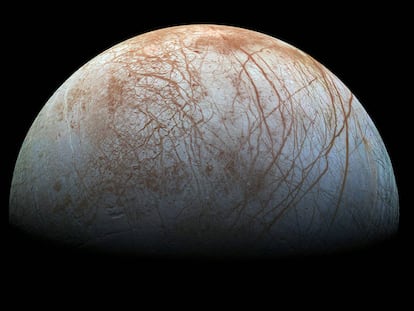‘Europa Clipper’: NASA launches largest interplanetary spacecraft to search for traces of life on Jupiter’s moon
A vast ocean hidden beneath the ice on Europa is one of the most likely places to find organisms beyond Earth

The largest interplanetary spacecraft built by NASA took off on Monday at 18:06 CET aboard a SpaceX Falcon Heavy rocket. The launch had been on hold due to Hurricane Milton passing through Florida, where the Kennedy Space Center at Cape Canaveral is located. The Clipper mission’s destination is Europa, one of Jupiter’s icy moons. Despite temperatures of more than 200ºC below zero and radiation that would kill a person in hours, it is one of the places with the greatest chance of harboring life beyond Earth.
Mission managers have asked SpaceX to remove all the engines and circuits that are normally used to recover used Falcon Heavy stages from the rocket, as Clipper needs the maximum possible thrust to escape Earth’s gravity and complete its journey of nearly three billion kilometers to Jupiter’s remote satellite. During the launch, it broke the speed record for the second stage of the booster, reaching some 40,000 kmph.
“Clipper is going to be the first in-depth mission that will allow us to characterize habitability on what could be the most common type of inhabited world in our universe,” Gina DiBraccio, NASA’s acting chief of planetary science, said at a news conference.
So far, over 5,700 exoplanets have been discovered beyond the solar system. The vast majority are gas giants like Jupiter, which has 95 moons. If it is proven that Europa was the site of a second origin of life, the chances of it occurring elsewhere in the cosmos increase.
Europa’s surface is a 20-kilometer-thick layer of ice, in which deep, reddish cracks can be seen that look like the veins in a giant eye. This may be sulfur, a compound associated with volcanism. In the so-called Chaos Terrains, the cracks in the ice are no older than 90 million years, an instant in geological terms. This implies that there must be some kind of subterranean activity. Scientists know that beneath the ice there is a deep global ocean that contains twice as much water as all the oceans on Earth. And at the very bottom there would be a rocky bed with possible thermal activity. “They may be similar to thermal vents in the deep oceans of the Earth where primitive life exists and where life may have originated on the Earth,” explains Bonnie Buratti, one of the chief scientists on the mission.
This Jovian moon is about the same size as our own, and probably contains all three essentials for life: water, organic compounds, and energy. It has also had plenty of time to evolve, as Jupiter was one of the first planets to form after the Sun came into being, some 4.5 billion years ago. Europa is made of the same materials as its home planet. Clipper’s main goal is to confirm there could be life in Europa’s ocean, probably microbes that don’t need oxygen to survive, just minerals and the energy emanating from its interior.
Europa Clipper takes its name from the legendary 19th-century sailing ships that crossed the Atlantic in record time. Its dimensions are impressive: over 30 metres from tip to tip of its enormous solar panels, and six metres high. It is the largest interplanetary ship ever developed by NASA, and also one of the most expensive at a cost of around $5 billion.
A real power move! ⚡️ Here's a look at engineers and technicians at @NASAKennedy deploying the first of two massive solar arrays that will provide electricity for our spacecraft at Jupiter – which is more than five times as far from the Sun as Earth. pic.twitter.com/KWtEogGZAC
— NASA Europa Clipper (@EuropaClipper) August 16, 2024
Clipper will study Europa in a level of detail never before achieved. Its nine scientific instruments will be able to see details on the moon’s surface with a resolution of one meter. Radars will clarify how deep the ice shell is, fine-tune the depth of the ocean, and look for pockets of liquid water on the surface and hot spots where minerals and perhaps microbes are also oozing out. “There is very strong evidence that the ingredients for life exist on Europa. But we have to go there to find out,” Buratti said. “We can identify organic compounds [oxygen, carbon, hydrogen] on the surface that are the precursors of life.” The mission, the veteran planetary scientist and astronomer emphasizes, is “not a life-detection mission. We’re just looking for the conditions for life.”
Jupiter is the largest planet in the solar system, but it is so violent that it is more like a star. It generates a magnetic field around itself that extends some 20 million kilometers and is filled with charged atomic particles accelerated to almost the speed of light. It is a post-nuclear war environment capable of frying the circuits of any ship that comes too close.
Earlier this year, mission managers realized that the craft contained dozens of chips that, contrary to what was believed, could stop working due to high radiation. NASA commissioned a race against time to analyze the real-life endurance of these components to decide whether launching Clipper would be practically useless. The results of the analysis indicate that the circuits will hold up, in part because they will be able to recover from high radiation as the craft will only spend one day in every 21 in the most dangerous environments.
The spacecraft will make up to 49 flybys of Europa, coming within just 25 kilometers of the surface — a record. But it is then scheduled to move away again before the next plunge. While Clipper is focused on Europa, a European spacecraft will be watching. The European Space Agency’s Juice mission was launched last year and is scheduled to arrive in the vicinity of Jupiter at the same time. This will allow one probe to observe the other as they make one of their close approaches to the Jovian moons; an unprecedented dance of spacecraft in the outer reaches of the solar system.
“If I had to bet on where there is life in the solar system beyond Earth, I would definitely choose Europa or Enceladus [Saturn’s moon],” says Olga Prieto Ballesteros, a geologist at the Centre for Astrobiology near Madrid who is taking part in the Juice mission. The European probe has broader goals — studying Jupiter’s magnetic field and focusing on mapping Ganymede, another of its icy moons.
Clipper is scheduled to arrive at Jupiter in April 2030, and Juice in the middle of the following year. Their useful life will be about four years, partly because of the enormous wear of radiation. At the end of their lives, both ships will crash land on Ganymede so as not to contaminate Europa and any possible life it contains.
Sign up for our weekly newsletter to get more English-language news coverage from EL PAÍS USA Edition
Tu suscripción se está usando en otro dispositivo
¿Quieres añadir otro usuario a tu suscripción?
Si continúas leyendo en este dispositivo, no se podrá leer en el otro.
FlechaTu suscripción se está usando en otro dispositivo y solo puedes acceder a EL PAÍS desde un dispositivo a la vez.
Si quieres compartir tu cuenta, cambia tu suscripción a la modalidad Premium, así podrás añadir otro usuario. Cada uno accederá con su propia cuenta de email, lo que os permitirá personalizar vuestra experiencia en EL PAÍS.
¿Tienes una suscripción de empresa? Accede aquí para contratar más cuentas.
En el caso de no saber quién está usando tu cuenta, te recomendamos cambiar tu contraseña aquí.
Si decides continuar compartiendo tu cuenta, este mensaje se mostrará en tu dispositivo y en el de la otra persona que está usando tu cuenta de forma indefinida, afectando a tu experiencia de lectura. Puedes consultar aquí los términos y condiciones de la suscripción digital.
More information
Archived In
Últimas noticias
Trump claims peace in Ukraine is near, but Moscow suggests otherwise
A survivor’s account of the Interoceanic Train accident: ‘We were scared because of the speed on the curve’
The Interoceanic Train, the Mexican alternative to the Panama Canal
What is known about the Interoceanic Train derailment in Oaxaca
Most viewed
- Oona Chaplin: ‘I told James Cameron that I was living in a treehouse and starting a permaculture project with a friend’
- Reinhard Genzel, Nobel laureate in physics: ‘One-minute videos will never give you the truth’
- Why the price of coffee has skyrocketed: from Brazilian plantations to specialty coffee houses
- Pablo Escobar’s hippos: A serious environmental problem, 40 years on
- Chevy Chase, the beloved comedian who was a monster off camera: ‘Not everyone hated him, just the people who’ve worked with him’










































